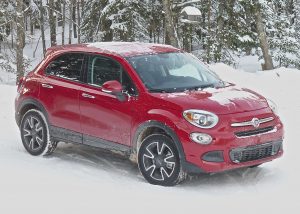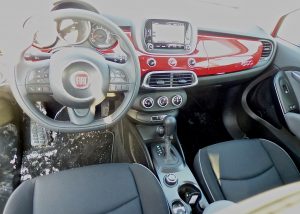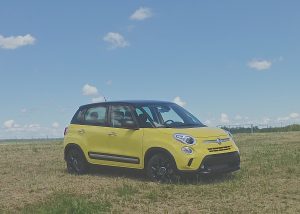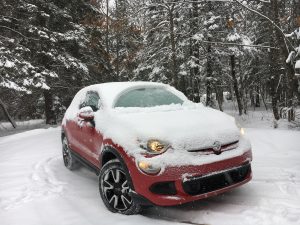Cute Fiat 500x handles ‘Minnesota Riviera’
By John Gilbert
If you want to escape from the rigors of Northern U.S. wintertime, what better destination than sunny Italy? It doesn’t seem as logical to go from Italy to Northern Minnesota’s ice-locked clime in January, but that’s what my little red Fiat 500x did for a week.
I knew it was not overmatched, when we got hit with a Duluth-quality blizzard of 6-8 inches of snow, followed by a bone-chilling 20-below-zero frigid spell. My wife, Joan, delivered a bowl of hot oatmeal in the dawn’s early light, and as I finished a follow-up cup of coffee, I stood up, pulled out the Fiat 500x key fob and aimed it out the kitchen window. Push the button twice, watch the lights blink, and notice the exhaust vapor streaming out of the tailpipes. Autostart. What a wonderful invention.
When it was time to leave, I bundled myself into my favorite down parka and headed out, climbing into an already soothingly warm vehicle. With all-wheel drive in the 500x, all was well. Well, almost. The only failure of the Fiat 500x is the inclusion of Nexen tires, which I’m sure are very smooth, round Korean-made tires for nearly every road surface. “Nearly every” does not include Duluth, Minnesota, avenues in wintertime.
Switching the 500x to all-wheel drive didn’t help much, because the Nexens wanted to slither around dangerously anytime you applied throttle. I found, in fact, that leaving the 500x in front-wheel drive worked almost better, because you only had the front tires spinning and slithering instead of all four seeking their own direction.
We have a joint venture here, with an American company contributing a lot to the mix, an Italian company putting it all together, and a Korean company supplying the basic 2.4-liter engine design, and those Nexen tires.
If the 500x had some highly competent all-season or winter tires — my choice continues to be Nokian — the car would have been the greatest winter “sleeper” car on the planet. As it was, an AWD crossover shouldn’t require white-knuckling inside your gloves.
When Fiat re-entered the United States market with the 500, it was roundly celebrated for being almost hopelessly cute. Much like the Volkswagen Beetle and the Mini Cooper, which brought plenty of memories and old-time charm a couple of decades ago, the Fiat 500 was rounded, small, definitely retro, and driving it with its modern but tiny engine was a kick. I used to write that it was impossible to drive a Mini Cooper without a smile on your face, and the same goes for the 500.
Fiat, which was in the process of taking over Chrysler-Jeep-Ram to form FCA — Fiat-Chrysler Automobiles — was in a hurry. So the 500 soon sprouted a semi-convertible, then an elongated 500L, and finally the 500x. Small “x” please. The 500x hit the market at the perfect time. Consumers in the U.S. had shifted their miogration to small compact SUVs — or CUVs, for crossover utility vehicles — and no manufacturer could make enough small utility vehicles. I’m not certain if Fiat read the tea-leaves to come out ahead of the trend, but more likely the timing was just coincidental.
But the 500x is that cute little 500 enlarged as though it had been fed steroids, and plunked onto an all-wheel-drive platform. And not just any AWD. As new owner of the outfit that produces Jeeps, it was time for Jeep to add a new small vehicle, and it came up with the Renegade, a small and cute little member of the Jeep family, smaller than the very competent Cherokee and smaller than the Compass and other models in the line. But it was extremely competent in off-road duties, willing to rock-climb with the best of them while also maintaining decorum in highway driving.
Unbeknown to most, the squarish, compact and contemporary Renegade is built in a Fiat plant in Melfi, Italy, because Fiat intended to sell the Renegades in Italy as well as ship them to the U.S. It was a convenient and logical move, then, to take that 500x body and enlarge every dimension into a larger but still pleasantly rounded form, and then plunk it down on the Renegade platform.
As if by magic, you can choose which “Jeep” you like best, the one with the 1.4-liter base 4-cylinder turbo, worth 160 horsepower and 184 forced-air foot-pounds of torque, or the optional 2.4-liter MultiAir 4-cylinder, putting out 180 horses and 175 foot-pounds of normally-aspirated torque. You can also select between front-wheel drive or all-wheel drive, although personally, anybody buying a Jeep of any color should only be considering the 4WD version.
But now you can also choose what exterior form you prefer — the trendy, cute, and squarish dimensions of the Jeep Renegade, or the super-cute sleeper version encased in the Fiat 500x body. Both of them come with your choice of a 6-speed manual, mainly in the FWD version, or the 9-speed automatic, which smoothly upshifts its way up to and beyond highway speeds.
Curiously, the Fiat gets better EPA fuel economy estimates, reaching to 34 miles per gallon highway, compared to the Renegade’s 31 mpg. Sticker prices start at $21,000 for the 500x, and range from $19,000-$28,000 in the Renegade. The test 500x had the 2.4 and the 9-speed, and with satellite radio and other connectivity and safety upgrades it started at $24,635 with an as-tested tag of $27,430.
Small on the outside but surprisingly roomy inside, the 500x has adequate storage room behind the fold-down rear seats even when they’re up. Handling is quick and precise, and it isn’t an exaggeration to call it fun to drive. Except for those darn tires.
The test 500x was a wonderful shade of red. Why is it that Italians can come up with various red paint jobs that are all superb? This one isn’t metallic, just flat red. It is called Rosso Passione, which is followed by the parenthetical explanation: Red Hypnotique Clear Coat. We’ll stick with red, but you get the idea.
A neat touch is that the interior is well-appointed, and I really like the basic idea that the dashboard has a glossy red metal facing — same color as the exterior. Very classy.
The 9-speed automatic transmission sends the 500x on its way, revving smoothly and shifting without any jerks or irregularities. The rotating knob on the console needs to be switched to the right a third of a turn to engage all-wheel drive, and while it works fine, once you stop and shut off the engine, it defaults to front-wheel drive when you next start up. That caught Joan by surprise once, but it makes sense when you think about it; it’s too easy to shut the vehicle off and start up again and leave it in all-wheel drive for long stretches of dry pavement, which is unnecessary and wastes a little gas.
Defaulting to FWD means if you feel any uneasiness, switch it back to 4WD and all is well. All the anticipated safety and creature features are present, although a friend in the auto-writing business wouldn’t like the absence of a heated steering wheel.
The manually adjustable bucket seats were easy to operate and I never once wished it had power seats. Navigation, back-up camera and cross-traffic and blind-spot detection make the 500x fully equipped. Another option on the test vehicle were 17-inch alloy wheels.
I like the looks of them, but I have one redundant suggestion for Fiat: Put Nokian tires on all the 500x models you send to Minnesota, Wisconsin, Upper Michigan, North Dakota, and all other points across the nation’s snow-belt states.







 John Gilbert is a lifetime Minnesotan and career journalist, specializing in cars and sports during and since spending 30 years at the Minneapolis Tribune, now the Star Tribune. More recently, he has continued translating the high-tech world of autos and sharing his passionate insights as a freelance writer/photographer/broadcaster. A member of the prestigious North American Car and Truck of the Year jury since 1993. John can be heard Monday-Friday from 9-11am on 610 KDAL(www.kdal610.com) on the "John Gilbert Show," and writes a column in the Duluth Reader.
John Gilbert is a lifetime Minnesotan and career journalist, specializing in cars and sports during and since spending 30 years at the Minneapolis Tribune, now the Star Tribune. More recently, he has continued translating the high-tech world of autos and sharing his passionate insights as a freelance writer/photographer/broadcaster. A member of the prestigious North American Car and Truck of the Year jury since 1993. John can be heard Monday-Friday from 9-11am on 610 KDAL(www.kdal610.com) on the "John Gilbert Show," and writes a column in the Duluth Reader.